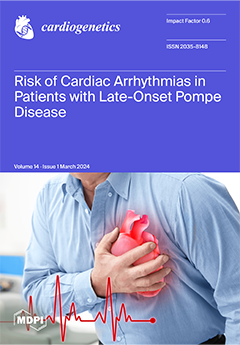Background. Pompe disease is a rare, severe, autosomal recessive genetic disorder caused by
GAA gene mutations, which cause α-1,4-glucosidase enzyme deficiency. There are two forms of Pompe disease based on the age of onset, the infantile and the adult form (LOPD). Cardiac
[...] Read more.
Background. Pompe disease is a rare, severe, autosomal recessive genetic disorder caused by
GAA gene mutations, which cause α-1,4-glucosidase enzyme deficiency. There are two forms of Pompe disease based on the age of onset, the infantile and the adult form (LOPD). Cardiac involvement, previously recognized only in infantile cases, is now also reported in adults. Cardiomyopathy remains an exceptional finding while heart rhythm disorders appear to be more frequent.
Methods. We retrospectively evaluated cardiac involvement in 12 patients with late-onset Pompe disease (LOPD) followed for an overall period of 143 years (mean 12.7 ± 7.7) using ECG, Holter ECG, and echocardiography.
Results. The mean age of patients (M8:F4) at the first visit was 40.7 ± 16.1 (range 14–63) and 53.7 ± 16.9 (range 21–76) at last visit. Conduction delay was present in three patients; one patient developed ascending aorta ectasia but had a history of hypertension, and one patient showed right heart enlargement on echocardiography, probably due to pulmonary hypertension. No patient died during the FU, nor developed cardiomyopathy. Ectopic supraventricular beats and repeated episodes of ablation-resistant atrial fibrillation were observed in only one patient (8.3%) who required PMK implantation.
Conclusions. Benefitting from the long follow-up, this study allows us to state that primary myocardial involvement is rare in patients with LOPD, while rhythm disorders are more frequent and require monitoring to avoid the risk of possible life-threatening complications.
Full article





